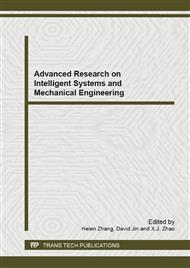p.72
p.77
p.81
p.85
p.89
p.93
p.97
p.101
p.105
Finite Element Analysis and Design of Cylinder Shell Resonant Density Meter Based on Mechanical Vibration and Fluid-Solid Interaction
Abstract:
In order to solve the problem of choosing vibration mode of the cylinder shell resonating density meter, this paper analysis the dynamics of the resonator by ANSYS. The modal analysis result shows that the transverse n=2 and n=3 all meet the requirement, the fluid-structure interaction result shows that the transverse n=2 is more sensitive to the changing of fuel density than n=3. Final analysis of the influence by temperature and pressure on the vibration frequency shows that the influence by pressure is very little which can be omitted, but the influence by temperature is remarkable and needs to be compensated. The conclusions and methods of finite element analysis can be used for resonant liquid density meter design.
Info:
Periodical:
Pages:
89-92
Citation:
Online since:
January 2013
Authors:
Price:
Сopyright:
© 2013 Trans Tech Publications Ltd. All Rights Reserved
Share:
Citation:


